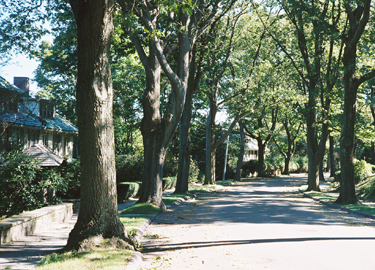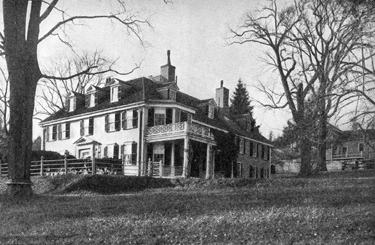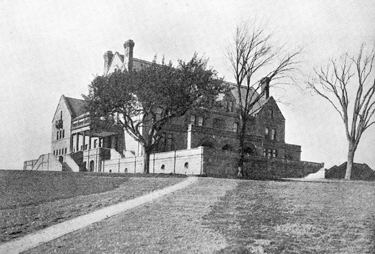
With its picturesque setting above the reservoir, majestic trees, splendid turn-of-the-century homes, and gently curving lanes, Fisher Hill epitomizes the genteel suburb that ideal combination of natural features and domestic tranquility. Also known as Brookline Hill, Mount Vernon, and Henshaw Hill, it was ultimately named after Francis Fisher, a Boston merchant whose 1852 estate was built at the corner of Boylston Street and Chestnut Hill Avenue.
A glacial drumlin that rises 240 feet above sea level, Fisher Hill is bounded by Boylston Street on the south, Chestnut Hill Avenue on the west, the MBTA train tracks on the north, and Cypress Street on the east. The hill's earliest homes were farmhouses built on the south slope overlooking "the Sherburne Road" (Boylston Street). As with the rest of Brookline, the early 1800's brought wealthy Boston merchants to the hill in their quest for a bucolic yet convenient setting for their summer country estates. An early resident, Benjamin Goddard, built his home on the Sherburne Road in 1810-11 opposite the future site of the Brookline Reservoir. His heirs formed the Goddard Land Company, initiating the development of Fisher Hill. Later, with the advent of the Boston and Worcester railroad in 1847, and the construction of the Brookline Reservoir in 1844, access and a scenic setting conspired to entice commuters to Fisher Hill.
Olmsted's Subdivision
Fisher Hill received its designation as a National Register Historic District in 1984, exactly 100 years after F.L.Olmsted and his stepson J.C. Olmsted were asked to design a subdivision on "Brookline Hill." Working from their nearby home and office at 99 Warren Street, they created one of their finest subdivision designs. The neighborhood has remained substantially unchanged, making Fisher Hill the most intact Olmsted designed subdivision in the country. Not long after building, residents noticed that rapidly increasing housing demand and land values in Brookline were causing the demolition of relatively new single-family homes to make way for apartments. In response, 165 property owners signed a covenant in 1914 stating that "they would not allow the deterioration of their property through the construction of apartment houses, 2-family homes, public garages, stores, and hospitals." This restriction pre-dated the protections now handled through municipal mechanisms such as zoning, design guidelines, and historic districts. The covenant expired in 1940, by which time the town had established zoning.
The History of 617 Boylston Street
One cannot consider the history of Fisher Hill without telling the storied past of 617 Boylston Street, known now by the cumbersome name of the Boylston/Hyslop/Lee house, which is a recitation of previous owners. Set back on the hill's south facing slope, it overlooks the western end of the Brookline Reservoir. An early part of the house dates to 1660, but the main part was built in 1736, with subsequent additions. The story begins with Thomas Boylston, who came from England and settled in Watertown in 1635. His son Thomas was born in Watertown in 1644, became a surgeon, and married Mary Gardner of Muddy River in 1665. The couple settled in the 617 Boylston house and had twelve children of their own. The second child, Dr. Zabdiel Boylston was born in 1680 and achieved notoriety by introducing an inoculation for smallpox in 1721. Before it was proven effective, the inoculation was extremely controversial. Dr. Zabdiel purchased the house from his brother Peter, who had inherited it. Next to own the home was Mr. William Hyslop, a native of Scotland, who became extremely successful as a textile merchant. His son David inherited the homestead. Henry Lee bought the house in 1850. He vehemently opposed a proposal that called for widening and putting a trolley line on Boylston Street, claiming it would disrupt the country atmosphere. Lee also planted the large old specimen trees that remain on the estate today. Margaret Richardson, the current owner, recently donated a conservation easement to the town that will preserve in perpetuity the old trees and the view of the landscaped grounds from the reservoir.
Reservoirs on the Hill
Another notable Fisher Hill family was that of Edward Philbrick, Boston water system engineer. It was Edward Philbrick who designed the two rectangular underground reservoirs located at the top of Fisher Hill. Built in 1875 on a 4.5-acre site, the reservoirs were filled with water pumped from the Charles River, and served as a back-up water supply for the town. This reservoir site is currently used as a storage yard for the Town's water department. The other reservoir on the hill was built by the city of Boston in 1884, and is currently owned by the MWRA. The 10-acre site includes a stone gatehouse that was probably designed by Arthur Vinal, Boston's city architect. The Town is currently in discussion with the MWRA about the possibility of using the site for open space and recreation.
Origins of the Longyear Museum
John and Mary Longyear's grand estate on the hill's crest was moved from its original location in Marquette, Michigan in 1903. Having made their fortune through their discovery of mineral deposits in the Great Lakes and in the coalfields of Norway, the couple wished to live near the Mother Church of the First Church of Christ Scientist in Boston. Moving their Richardsonian Romanesque "mansion" 1300 miles required two trains pulling 190 cars. Their home became an educational center for the Church, and upon Mary Longyear's death in 1931, the mansion and grounds became the Longyear Foundation, housing a museum and archive of early Christian Scientist documents and artifacts.
Today, the Longyear estate has been transformed into a luxury condominium development, "Longyear at Fisher Hill," and Newbury College has brought an institutional use to the hill. Despite these changes, Fisher Hill remains a beautiful neighborhood, recalling the grandeur of another era with stone walls, large old trees, wrought iron fences, brick sidewalks, and significant turn-of-the-century architecture. The neighborhood's cohesiveness is due to the integrity of Olmsted's sensitive layout, and the fact that the homes were built within a fairly short timeframe, under strict deed restrictions.

